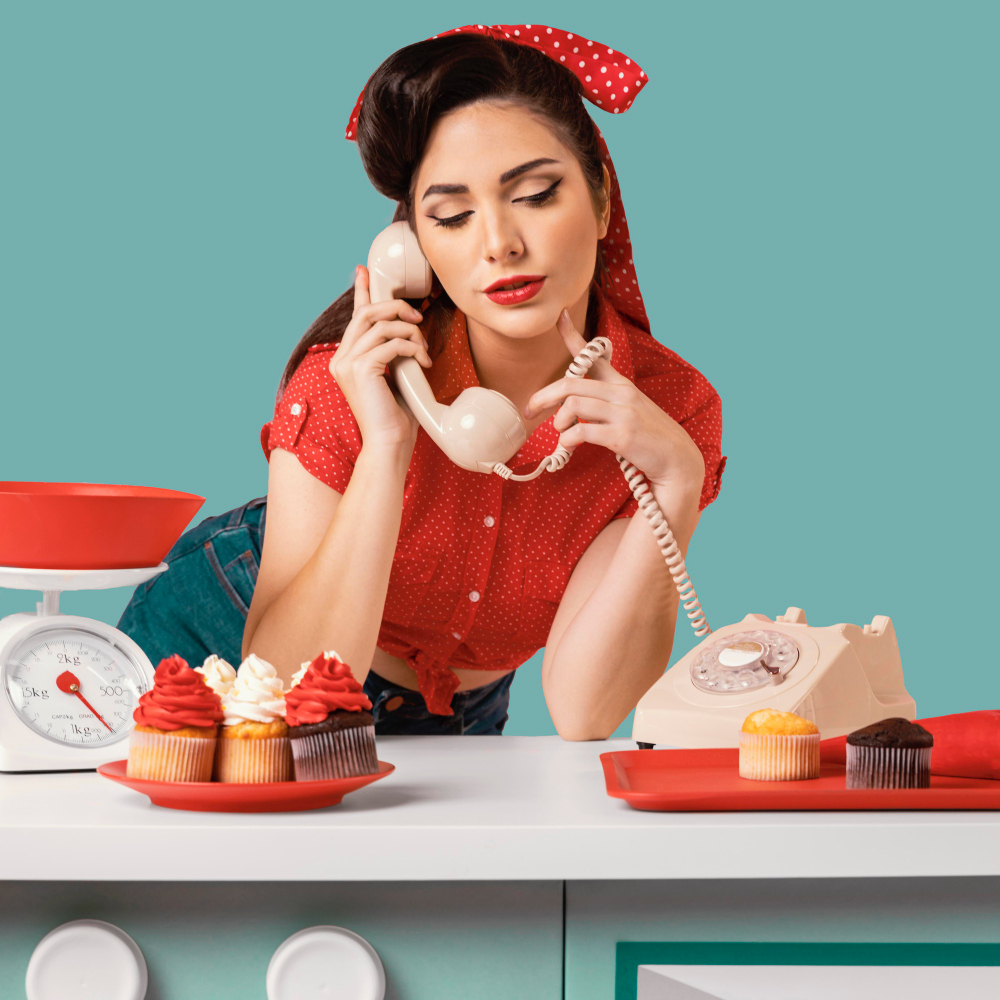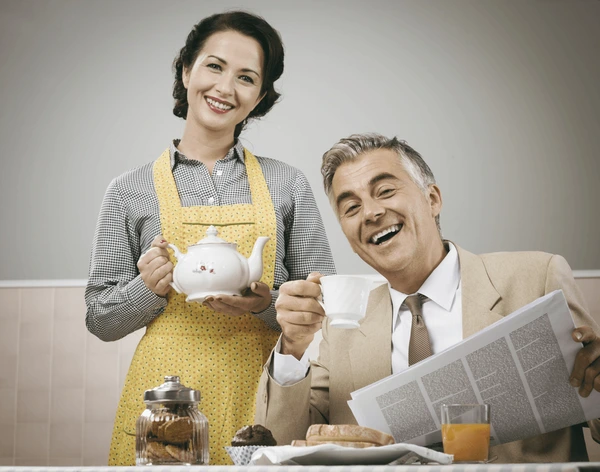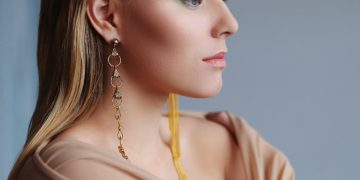Table of Contents
Introduction to American 1950s Housewife Fashion
The 1950s were a transformative decade for women’s fashion, particularly in America. After World War II, the country experienced economic prosperity and societal changes that heavily influenced the roles and appearance of women, especially housewives. The “American housewife” became a cultural icon, representing domesticity, modesty, and elegance. Fashion during this era wasn’t just about looking good; it reflected deeper societal expectations for women to maintain an idealized home life.
Cultural Influence on 1950s Fashion
The 1950s saw the emergence of television as a dominant medium, showcasing the picture-perfect housewives in shows like Leave It to Beaver and I Love Lucy. Magazines like Good Housekeeping and Ladies’ Home Journal also played a significant role in crafting the image of the well-dressed housewife. These media outlets promoted the idea that a woman’s primary role was to maintain a spotless home while looking effortlessly stylish.
The Hourglass Silhouette
One of the most defining features of 1950s housewife fashion was the hourglass silhouette. This exaggerated figure, with a cinched waist and full hips, became synonymous with femininity. Dresses were tailored to enhance this shape, often with the help of undergarments like girdles and crinolines. The emphasis on a small waist and fuller skirt created a dramatic yet sophisticated look that has since become emblematic of the decade.
Common Fabrics and Colors of the Era
Fabrics during the 1950s were practical yet stylish. Cotton and polyester were commonly used for everyday wear, while more luxurious fabrics like taffeta were reserved for special occasions. Colors ranged from soft pastels to bold, bright prints. Patterns like polka dots and floral designs were particularly popular, adding a playful touch to otherwise simple designs.
Signature Pieces of American 1950s Housewife Fashion
The Tea Dress
Tea dresses were a staple in every housewife’s wardrobe. These dresses typically featured a fitted bodice, a flared skirt, and short sleeves, making them perfect for both housework and social occasions.
Pencil Skirts
For a more formal look, pencil skirts were a go-to option. These skirts, which hugged the hips and narrowed at the knees, were often paired with tailored blouses or knit cardigans.
Circle Skirts
Circle skirts, with their voluminous flare, became iconic in the 1950s. Often worn with petticoats underneath for added fullness, they were a favorite for casual outings or even just for a day at home.
Aprons
The apron was more than just a protective garment in the 1950s—it was a symbol of domestic pride. Housewives often wore colorful, decorative aprons over their dresses, adding a personalized touch to their daily chores.

Accessories That Defined the Look
Accessories were crucial to completing the 1950s housewife look.
- Gloves: Whether short or elbow-length, gloves were a mark of elegance and respectability.
- Pearls: A string of pearls was the ultimate status symbol for the American housewife, often worn to reflect class and refinement.
- Hairstyles and Scarves: Perfectly coiffed hair was non-negotiable, and scarves were often used to keep hairstyles intact while working around the house.
The Role of Undergarments
Undergarments played a significant role in shaping the body to fit the fashion ideals of the time. Girdles were worn to cinch the waist, while bullet bras created a pointed bust, further emphasizing the hourglass silhouette. Crinolines and petticoats were layered under skirts to add volume, making the waist appear even smaller in contrast.
Footwear in the 1950s
Housewives in the 1950s had a range of footwear options, from practical flats to elegant kitten heels. Kitten heels offered the perfect balance between comfort and sophistication, allowing women to move easily while maintaining a polished appearance.
Makeup and Beauty Routines of the 1950s Housewife
The beauty standards of the 1950s emphasized a “natural” look, although achieving this look required a significant amount of makeup. Foundation, powder, and soft eye shadows were used to create a flawless complexion, while red lipstick was a must-have for any 1950s woman.
How American 1950s Housewife Fashion Reflected Societal Norms
Fashion in the 1950s wasn’t just about aesthetics; it reinforced societal norms and expectations. The modest, feminine style was a reflection of the era’s conservative values, where women were expected to maintain the home and present themselves as the ideal wives and mothers.
The Influence of Media on American 1950s Housewife Fashion
Media played a pivotal role in shaping the 1950s housewife’s fashion choices. Television became more widespread in American homes, and women frequently tuned into shows like “I Love Lucy”, where actresses like Lucille Ball displayed the ideal housewife persona. These women were always impeccably dressed, even while doing mundane household chores. Their outfits — often featuring cinched waists and A-line skirts — reflected the dominant fashion trends of the era, encouraging women to mirror these styles in their everyday lives.
Hollywood stars like Grace Kelly, Audrey Hepburn, and Marilyn Monroe further cemented these ideals. Their portrayal of women as glamorous, refined, and put-together in movies and advertisements encouraged everyday women to strive for the same look, whether they were attending a social gathering or simply shopping for groceries.
Furthermore, the explosion of fashion magazines like Vogue and Harper’s Bazaar provided an avenue for women to keep up with the latest fashion trends. These magazines offered housewives tips on how to dress stylishly while maintaining their domestic roles, often blending practicality with elegance. Articles and images in such publications provided ideas for women on how to use clothing as a form of self-expression, while still fitting into societal norms.
American 1950s Housewife Fashion for Different Occasions
One of the most notable characteristics of 1950s housewife fashion was how outfits varied depending on the occasion. Women of this era paid meticulous attention to dressing appropriately for various parts of their day and events.

Everyday Wear: The Functional yet Feminine Look
For daily chores, housewives embraced shirtwaist dresses. These were designed with comfort in mind but did not compromise on style. Made from fabrics like cotton or polyester, the shirtwaist dress often featured a fitted bodice, a wide collar, and a full skirt, cinched at the waist. Some dresses came with matching belts to accentuate the hourglass figure even further.
Many women also wore pinafores, aprons designed to protect their dresses from stains while cleaning or cooking. While purely functional, pinafores often had decorative elements like embroidery, adding a touch of femininity.
Footwear for the daily housewife generally consisted of comfortable kitten heels or low-heeled pumps, offering both style and practicality. These shoes were ideal for women who needed to be on their feet while managing the household but still wanted to maintain their fashionable appearance.
Glamorous Evening Wear
When attending a social gathering, party, or dinner event, a housewife would change into something much more glamorous. Evening dresses, typically made from luxurious materials like taffeta or silk, were designed to make an impression. These dresses often featured intricate details such as bows, lace, and embroidery.
One popular style for evening wear was the strapless ball gown, which flared dramatically from the waist, embodying the pinnacle of 1950s elegance. Women would pair these gowns with long gloves, another staple accessory of the decade, which added an air of sophistication. Eveningwear was also accompanied by high heels, preferably stilettos, to further enhance the elegance of the overall look.
For slightly more casual evening occasions, women might wear a cocktail dress, which, while less extravagant than a full gown, still maintained a level of class and femininity. This type of dress had a shorter hemline but often featured the same waist-cinching design that characterized the era.
Outfits for Shopping and Errands
When stepping out of the house to run errands or go shopping, housewives in the 1950s aimed to present themselves well. For such outings, pedal pushers or capri pants became a trendy choice. These pants ended mid-calf and were often paired with button-up blouses or knitted sweaters. The look was both casual and functional but was still considered fashionable.
Women often carried leather handbags, which became an essential accessory for these outings. These bags, often medium-sized, were practical yet stylish, allowing women to carry their essentials while maintaining a put-together appearance.
Housewife Fashion for Special Occasions
Even for a casual dinner party at home, 1950s housewives dressed to impress. Evening wear often included cocktail dresses with fitted bodices and flared skirts, made from luxurious fabrics like silk or velvet. These dresses were paired with pearls, gloves, and heels to create a glamorous yet appropriate look for hosting guests.
How the Fashion Industry Marketed to Housewives
During the 1950s, the fashion industry heavily marketed to housewives. Companies recognized that women were the primary decision-makers when it came to household spending, and they used targeted advertising to promote everything from clothes to home appliances.
Comparing American 1950s Housewife Fashion to Today
While the structured, modest style of the 1950s may seem outdated today, elements of this era’s fashion continue to inspire modern trends. The hourglass silhouette, for example, is still popular, and retro-inspired clothing often draws on the playful patterns and bright colors of the 1950s.
Conclusion
The fashion of the 1950s continues to have a lasting impact on modern style. While some aspects of the era’s fashion reflect outdated gender roles, there’s no denying the elegance and charm of the 1950s housewife look. Whether through the revival of vintage trends or simply as a nostalgic nod to a bygone era, the fashion of the 1950s remains iconic.
FAQs
What were the most popular colors for American 1950s housewife fashion?
Soft pastels and bright prints, especially floral designs and polka dots, were common.
Why did 1950s housewives dress so formally?
Women dressed formally because societal norms emphasized femininity and a polished appearance, which reflected a housewife’s role and status.
Why were hourglass figures emphasized in 1950s fashion?
The hourglass silhouette was idealized for its feminine form, emphasizing small waists and full skirts, aligning with the post-war return to traditional gender roles.
What fabrics were popular in 1950s housewife fashion?
Cotton and polyester were common for daily wear, while taffeta and silk were used for more formal occasions.
How did the rise of television influence fashion in the 1950s?
Television showcased fashionable women in shows, influencing everyday housewives to adopt similar styles and maintain a well-groomed appearance.

















































